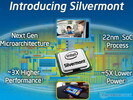Intel Celeron N2930 vs Intel Core 2 Duo T9400
Intel Celeron N2930
► remove from comparison
The Intel Celeron N2930 is a power efficient quad-core SoC for entry-level notebooks. It is clocked at 1.83 - 2.16 GHz and part of the Bay Trail-M platform. Thanks to the specially optimized 22 nanometer low-power process (P1271) with tri-gate transistors, performance and energy efficiency have been significantly improved compared to previous Intel Atom CPUs. The N2930 supports Quick Sync as well as Wireless Display.
Architecture
The processor cores are based on the new Silvermont architecture, which is an out-of-order design for the first time. The increased utilization of the pipeline and many other improvements (optimized branch prediction, increased buffers, enhanced decoders) have increased the performance per clock by about 50 percent. At the same time, however, the Hyper-Threading feature of the previous generation has been removed. Other major changes are the support for new instruction set extensions such as SSE 4.1 and 4.2 as well as AES-NI (depending on the model).
Performance
Thanks to the improved performance per clock and the 4 cores, the Celeron N2930 is significantly faster than previous Intel Atoms, e.g. the N2800. Depending on the benchmark, the N2930 competes with AMD Kabini APUs like the A4-5000. For most everyday tasks such as Internet or Office the performance is adequate, but not for complex software or modern games.
Graphics
The HD Graphics (Bay Trail) is based on the Intel Gen7 architecture, which supports DirectX 11 and is also found in the Ivy Bridge series (e.g. HD Graphics 4000). With only 4 EUs (Execution Units) and a relatively low clock speed of 313 - 854 MHz, the GPU is even slower than the HD Graphics (Ivy Bridge). Therefore, only older and less demanding games will run fluently.
Power Consumption
The entire SoC is rated at a TDP of 7.5 watts. Thus, the chip can be used in compact (and sometimes even passively cooled) subnotebooks and tablets.
Intel Core 2 Duo T9400
► remove from comparison
The Intel Core 2 Duo T9400 was a uppder middle class dual core CPU for laptops, at the time of introduction. It is similar to the Core 2 Duo P9500 except for the higher TDP of 35 versus 25 Watt).
Due to the relatively high clock speed and 6MB Level 2 cache, the T9400 offers enough performance for most demanding games (in 2009) and applications.
The T9400 uses a Penryn (Montevina Update) core that features 2 integer units, 1 floating point unit, 1 load unit, and 1 store unit in a 14-stages long pipeline. Due to the Wide Dynamic Execution Technology, the core is able to simultaneously execute up to four instructions.
The integrated Enhanced Speedstep is able to downclock the core dynamically to save power (in idle mode).
| Model | Intel Celeron N2930 | Intel Core 2 Duo T9400 | ||||||||||||||||||||||||||||||||||||||||||||||||||||
| Codename | Bay Trail-M | Penryn | ||||||||||||||||||||||||||||||||||||||||||||||||||||
| Series | Intel Celeron | Intel Core 2 Duo | ||||||||||||||||||||||||||||||||||||||||||||||||||||
| Series: Core 2 Duo Penryn |
| |||||||||||||||||||||||||||||||||||||||||||||||||||||
| Clock | 1830 - 2160 MHz | 2530 MHz | ||||||||||||||||||||||||||||||||||||||||||||||||||||
| L1 Cache | 224 KB | 128 KB | ||||||||||||||||||||||||||||||||||||||||||||||||||||
| L2 Cache | 2 MB | 6 MB | ||||||||||||||||||||||||||||||||||||||||||||||||||||
| Cores / Threads | 4 / 4 | 2 / 2 | ||||||||||||||||||||||||||||||||||||||||||||||||||||
| TDP | 7.5 Watt | 35 Watt | ||||||||||||||||||||||||||||||||||||||||||||||||||||
| Technology | 22 nm | 45 nm | ||||||||||||||||||||||||||||||||||||||||||||||||||||
| max. Temp. | 105 °C | 105 °C | ||||||||||||||||||||||||||||||||||||||||||||||||||||
| Socket | FCBGA1170 | BGA479, PGA478 | ||||||||||||||||||||||||||||||||||||||||||||||||||||
| Features | HD Graphics (Bay Trail, 313 - 854 MHz), Quick Sync, Wireless Display, Speedstep | Virtualization Technology (VT-x), Trusted Execution, Intel 64, Enhanced Speedstep, Execute Disable Bit | ||||||||||||||||||||||||||||||||||||||||||||||||||||
| iGPU | Intel HD Graphics (Bay Trail) (313 - 854 MHz) | |||||||||||||||||||||||||||||||||||||||||||||||||||||
| Architecture | x86 | x86 | ||||||||||||||||||||||||||||||||||||||||||||||||||||
| Announced | ||||||||||||||||||||||||||||||||||||||||||||||||||||||
| Manufacturer | ark.intel.com | ark.intel.com | ||||||||||||||||||||||||||||||||||||||||||||||||||||
| FSB | 1066 | |||||||||||||||||||||||||||||||||||||||||||||||||||||
| Transistors | 410 Million | |||||||||||||||||||||||||||||||||||||||||||||||||||||
| Voltage | 1.050V-1.162V V | |||||||||||||||||||||||||||||||||||||||||||||||||||||
| Die Size | 107 mm2 | |||||||||||||||||||||||||||||||||||||||||||||||||||||
| $316 U.S. |
Benchmarks
Average Benchmarks Intel Celeron N2930 → 100% n=8
Average Benchmarks Intel Core 2 Duo T9400 → 149% n=8
* Smaller numbers mean a higher performance
1 This benchmark is not used for the average calculation












